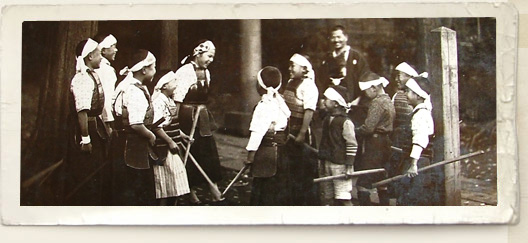
History
The Jikishin Kage-ryu Kenjutsu comes from a previous school, Kage-ryu Kenjutsu. A samurai called Aizu Hyuga no Kami Iko (1452-1538) founded Kage-ryu in 1490. He perfected, and taught his style around Japan. There are evidence from 1525, that another samurai, Kamiizumi Ise no Kami Nobutsuna (1508–1548) is teaching his own style, a form of Kage-ryu kenjutsu. He called it Shinkage-ryu (the school of the new shadow). Jikishin Kage-ryu means 'the newest school of the ancient shadow'. He was denoting with the name, to the ancestors, and expressing respect to his former masters. Matsumoto (Sugimoto) Bizen no Kami Naokatsu (1467-1524) was a famous master of this school, he also founded his own school first called Kashima Shinryu, then Kashima Shinden Jikishin Kage-ryu.
During the 19th century, Jikishin Kage-ryu was one of the most popular schools of combative swordsmanship (kenjutsu) in eastern Japan, especially in the Edo area. The 14th headmaster of Jikishin Kage-ryu Kenjutsu - Sakakibara Kenkichi (1829-1894) - was one of the most well-known swordsmen of his time, and the personal bodyguard of the Shogun.
Sakakibara had hundreds of students during his lifetime, many of them rising to the "rank" of menkyo kaiden, thus able to pass on the full tradition. A less well-known, but highly skilled, menkyo kaiden ranked student was Matsudaira Yasutoshi (1835-1880?), who, like Yamada Jirokichi (1863-1930), studied the more traditional ways of Jikishin Kage-ryu. The best apprentice of Yasutoshi was Makita Shigekatsu (1849-1914), a young man from a samurai family from Hokkaido. His name, and Jikishin Kage-ryu became famous on the northern island in the times of the Japanese civil war in 1868. By sword fighting, he was an expert in kyudo, Japanese archery. He was the heir of the title of shihan of Jikishinkage-ryu, but unfortunately he was fighting a losing battle against the Emperor in the revolution. The cast of the samurai was disbanded, and he had to run. Later, he returned to Hokkaido, and opened his own dojo, called Jikishin Kan Dojo. He was teaching various martial arts, not just kenjutsu. His dojo was popular, in spite of the prohibition of the katana in 1876.
After Shigekatsu's death, the village of Atsuta raised a black granite obelisk in his memory. This memorial can be seen today. The family tradition has been taken by his grandson, Kimiyoshi Suzuki. Kimiyoshi is also a master of Goju-ryu Karate and Jikishin Kage-ryu Kenjutsu.
